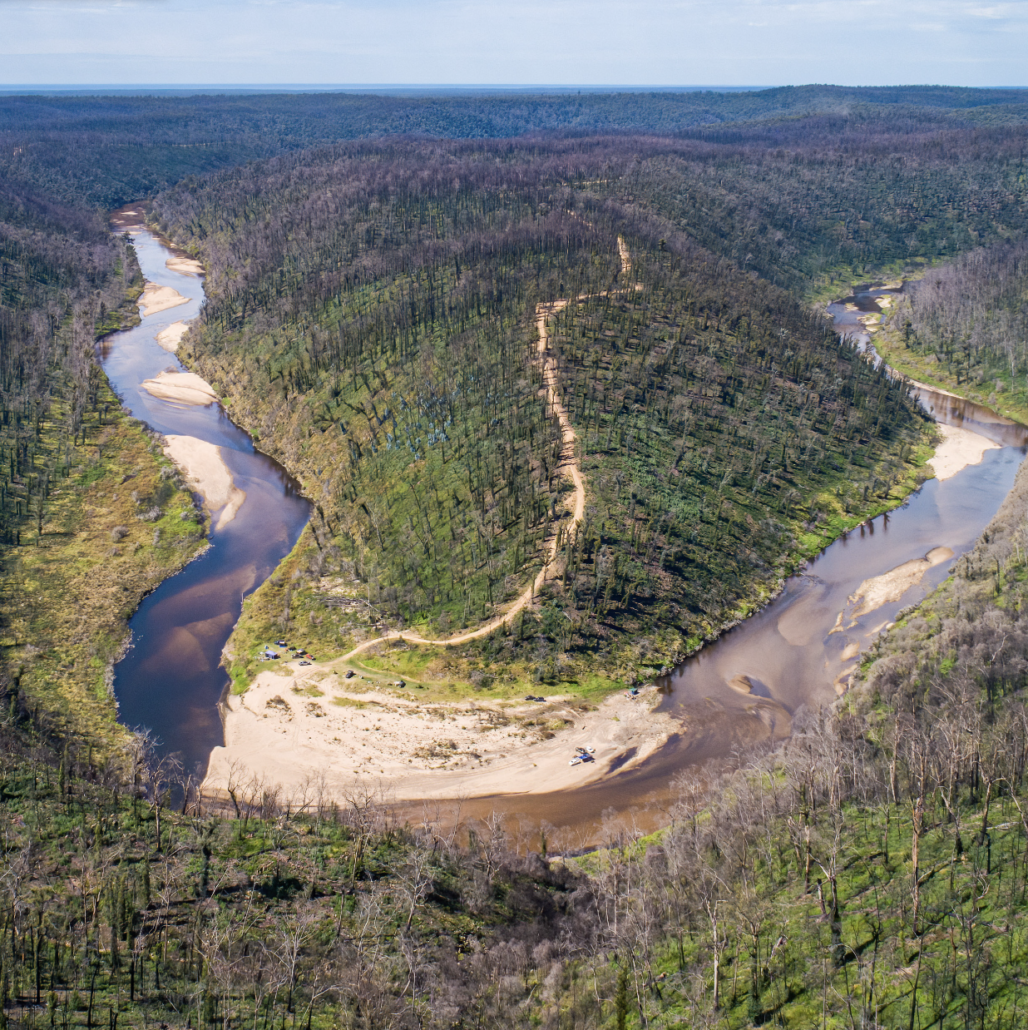Bushfire Recovery and Regional NRM Organisations
NRM organisations often play a pivotal role in response to bushfires, both immediately and over the longer-term. Regions are frequently among the first on-ground to assess and respond to impacts of bushfires on natural resources and biodiversity. As organisations embedded in their local communities, they are also often involved in longer-term recovery efforts and in working to manage fire and embed resilience and preparedness for future emergencies.
Following the 2019–20 wildfires, Natural Resource Managers responded to a huge diversity of needs: to care for ecosystems, soils, waterways, species, heritage, and culturally significant sites, working with First Nations communities to support recovery and fire management, supporting landholders and community recovery, and drawing together networks to prioritise actions. The severe impacts from fires of this scale on communities and organisations place significant pressures on systems in place for biodiversity and landscape management. A pre-existing knowledge base supported rapid response and effective prioritisation, but is uneven across landscapes, species and ecosystems.
NRM Regions Australia project- Knowledge for Capacity in Bushfire Recovery
In recognition of the vital role NRM organisations play in bushfire recovery, the Australian Government Department of Climate Change, Energy, the Environment and Water (DCCEEW) have provided funding to NRM Regions Australia until June 2023 to help draw together knowledge, resources and lessons from the 2019-20 wildfires and build capacity and resilience in regional NRM organisations to respond to future emergencies. This project supports:
- A part-time Bushfire Recovery Knowledge Broker.
- Coordination of a Bushfire Recovery Community of Practice to build peer learning, share knowledge and provide information and resources.
- Development and sharing of resources within the Knowledge Hub to support NRM staff.
Some of the resources from our Knowledge Hub are housed here in our website, but others can be accessed via our members-only Knowledge Hub and Collaboration spaces which you can login to from here.
If you would like more information, or to join the Bushfire Recovery Community of Practice, please get in touch with Knowledge Broker Rachel Morgain at [email protected].
Recent submissions
Stories of bushfire recovery and resilience
Bushfire Recovery Publications from NRM Regions
Videos
Webinar: Facing the rising risks to ecosystems of fire, flood, cyclones and climate extremes
Australian ecosystems are facing rising risks from climate extremes and natural hazards, compounded by ongoing pressures such as invasive species, fragmentation, declining water and soil health. This webinar discusses approaches from research and natural resource management to building resilience and making decisions in the face of compounding challenges, and draws on the real-world experiences of NRM managers building resilience to wildfires, floods and cyclones.
Webinar: Coordinating to protect culture and biodiversity in the heat of wildfires
This second webinar in our joint series with the National Environmental Science Program's Threatened Species Recovery Hub covers how Australia's 2019-2020 wildfires tested the capacity of people and systems across several states to conserve threatened species and ecological communities, and highlighted the urgency for resourcing First Nations heritage protection and fire management. This webinar brings together perspectives from researchers, managers and policy makers to discuss what we can learn from these events, and what systems or responses are needed to better protect biodiversity and empower First Nations leadership in the heat of bushfire events.
Webinar: Saving wildlife after bushfires: what is the evidence for effective action?
As part of a collaborative project on Bushfire Recovery in 2021, NRM Regions Australia ran a double webinar series jointly with the National Environmental Science Program's Threatened Species Recovery Hub in 2019. The first of these addressed the evidence for actions to support wildlife recovery following the fires. Featuring stories from Kangaroo Island and the Australian Capital Territory, and research led by ANU into evidence for fauna recovery, the webinar discusses what we know, what we don't know, and what we hope to learn about the effectiveness of the actions we can take to protect and recover fauna during devastating wildfires.
Biodiversity costs and lessons from the 2019-20 wildfires with John Woinarski
Professor John Woinarski is an esteemed conservation researcher, and was Deputy Chair of the Australian Government's Wildlife and Threatened Species Bushfire Recovery Expert Panel in 2020. He has led a large collaboration reviewing the consequences for biodiversity of the 2019-20 fires and the national response. Here he presents a summary of those findings to the NRM Regions Australia Bushfire Recovery Community of Practice.
Coordinating systems to protect biodiversity during bushfires: lessons from 2019-20 with Libby Rumpff
Associate Professor Libby Rumpff (University of Melbourne) speaks at our Bushfire Recovery Community of Practice, presenting findings from her research project on creating systems, processes and policy responses to protect biodiversity during wildfires, drawing on lessons from the 2019-20 wildfires.
Recovery and management of SEQ lowland subtropical rainforest after fire - Paul Donatiu
In September 2019, fire devastated 10 major fire grounds in South East Queensland lowland subtropical rainforest, including Gondwana Rainforests World Heritage Areas at Mt Barney, Main Range and Lamington National Park. This presentation by Paul Donatiu from Healthy Land and Water outlines the impacts from the fires, the recovery of rainforest systems, and the actions taken to support that recovery. It was presented as part of a series to the NRM Regions Australia Bushfire Recovery Community of Practice ecosystem recovery workshop.














